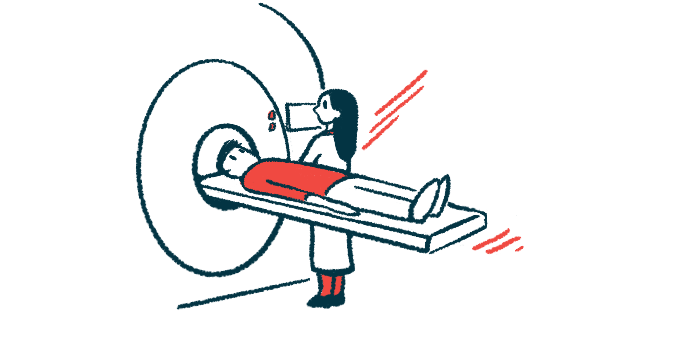Using noninvasive test combo can correctly distinguish Cushing’s
Study finds dexamethasone test, MRI combine for accurate diagnosis
Written by |

A combination of two noninvasive tests — the dexamethasone suppression test and high-resolution MRI scans — was found to correctly distinguish between Cushing’s disease and ectopic Cushing’s syndrome in patients, according to a new study.
The accuracy seen in combining these tests was comparable to that of bilateral inferior petrosal sinus sampling, or BIPSS, an invasive procedure that’s currently the gold standard to distinguish the two conditions, the researchers found.
Moreover, the team noted that dexamethasone and MRI scans together outperformed BIPSS in accurately locating pituitary tumors, the cause of Cushing’s disease.
“In the current study, the diagnostic performance of [these] noninvasive evaluations [in combination] … is comparable to BIPSS,” the researchers wrote, adding that, “with the development of 3D [techniques], superior image quality [on MRI scans] … has been achieved, providing a reliable alternative to detect pituitary adenomas [tumors].”
The study, “Improved noninvasive diagnostic evaluations in treatment-naïve adrenocorticotropic hormone (ACTH)-dependent Cushing’s syndrome,” was published in the journal BMC Medical Imaging.
Cushing’s syndrome is characterized by elevated blood levels of the stress hormone cortisol, also called hypercortisolism. Over time, excessive cortisol levels can lead to symptoms that include weight gain, fat buildup around the face, back of the neck, and shoulder blades, changes in the skin and body hair, and emotional disturbances.
Cushing’s disease, the most common form of hypercortisolism, is caused by excessive production of the adrenocorticotropic hormone (ACTH) by tumors in the brain’s pituitary gland. High levels of ACTH then trigger the adrenal glands to produce too much cortisol. Ectopic ACTH syndrome, or EAS, involves ACTH production from a tumor outside the pituitary gland.
Gold standard diagnostic test, known as BIPSS, is invasive
BIPSS is a diagnostic test that analyzes ACTH levels in the blood from the veins draining the pituitary gland. The procedure is regarded as the gold standard to distinguish Cushing’s disease from EAS. However, BIPSS is invasive and not reliable for tumor lateralization, which refers to locating the tumor’s precise location.
“It is important to improve the diagnostic performance of noninvasive evaluations with high sensitivity and tumor lateralization accuracy,” the researchers wrote
To that end, the research team, from China, evaluated noninvasive diagnostic tests to distinguish between the two ACTH-driven conditions. Medical records were reviewed from 85 adults with Cushing’s disease and 10 with EAS who underwent various MRI scans of the pituitary gland, as well as the high-dose dexamethasone suppression test. Among the Cushing’s disease patients, 65% were women; the EAS individuals were evenly split by sex.
When healthy people are given dexamethasone, a type of medication that mimics the activity of cortisol, their cortisol levels drop. In people with ACTH-driven hypercortisolism, however, the body continues to produce excess cortisol, regardless of dexamethasone.
Three types of MRI scans were examined: conventional MRI (cMRI), dynamic MRI (dMRI), which involves a series of cMRI images measured in rapid succession, and high-resolution MRI (hrMRI) that provides more detailed pictures than cMRI. Images were independently evaluated by two neuroradiologists, one with 16 years of experience in the field of neuroradiology and the other with 25 years.
Noninvasive tests showed accuracy similar to BIPSS
The team first showed that BIPSS was highly effective at distinguishing Cushing’s disease from EAS, with an area-under-the-curve (AUC) of 0.98. AUC is a number between zero and one that reflects how well a test can tell two conditions apart — with values closer to one indicating better accuracy.
When the two neuroradiologists combined the results of the dexamethasone test with the images from the hrMRI scans, the accuracy in distinguishing between the two conditions was similar to that of BIPSS with AUCs of 0.95 and 0.98. However, the diagnostic performance using the other types of MRI scans (cMRI and dMRI) was inferior to that of BIPSS.
When researchers examined the results from Cushing’s disease patients alone, hrMRI was significantly better at detecting pituitary tumors with a higher degree of confidence than cMRI and dMRI.
The sensitivity of BIPSS in tumor lateralization, or its ability to correctly identify tumor location in Cushing’s disease patients, was 96.5%. This value was comparable to that found using hrMRI by both neuroradiologists at 90.6% and 95.3%.
As noninvasive diagnostic evaluations, [high-dose dexamethasone suppression test plus] hrMRI achieves high diagnostic performance comparable with gold standard (BIPSS), and it is superior to BIPSS in terms of tumor lateralization accuracy in patients with ACTH-dependent Cushing’s syndrome.
A total of 36 patients had lateralization predicted by the BIPSS intersinus ratio, or the difference in ACTH levels taken from opposing sinuses. Still, the surgical findings found 21 cases where the BIPSS lateralization prediction was correct, resulting in an accuracy was 58.3%.
Across all 85 Cushing’s disease patients, the accuracy of BIPSS to predict tumor location was 24.7%, which was significantly lower than that of hrMRI by both neuroradiologists, the data showed.
“As noninvasive diagnostic evaluations, [high-dose dexamethasone suppression test plus] hrMRI achieves high diagnostic performance comparable with gold standard (BIPSS), and it is superior to BIPSS in terms of tumor lateralization accuracy in patients with ACTH-dependent Cushing’s syndrome,” the researchers concluded.







